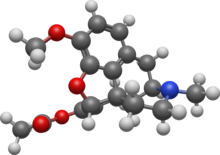 | |
 | |
| Clinical data | |
|---|---|
| AHFS/Drugs.com | International Drug Names |
| ATC code | |
| Legal status | |
| Legal status |
|
| Identifiers | |
| |
| CAS Number | |
| PubChem CID | |
| ChemSpider | |
| UNII | |
| KEGG | |
| ChEMBL | |
| CompTox Dashboard (EPA) | |
| ECHA InfoCard | 100.006.708 |
| Chemical and physical data | |
| Formula | C20H23NO4 |
| Molar mass | 341.407 g·mol−1 |
| 3D model (JSmol) | |
| |
| |
| | |
Thebacon (INN;[2] pronounced /ˈθiːbəkɒn/), or dihydrocodeinone enol acetate, is a semisynthetic opioid that is similar to hydrocodone and is most commonly synthesised from thebaine. Thebacon was invented in Germany in 1924, four years after the first synthesis of hydrocodone.[3] Thebacon is a derivative of acetyldihydrocodeine, where only the 6–7 double bond is saturated. Thebacon is marketed as its hydrochloride salt under the trade name Acedicon, and as its bitartrate under Diacodin and other trade names. The hydrochloride salt has a free base conversion ratio of 0.846. Other salts used in research and other settings include thebacon's phosphate, hydrobromide, citrate, hydroiodide, and sulfate.
YouTube Encyclopedic
-
1/5Views:72 53770 8616 170300 21715 126
-
How Not to Fall for Bad Statistics - with Jennifer Rogers
-
Heal, Feed, Sustain: How Biotechnology Can Help Save the World
-
UI/UX Design with Josh Iwata - 1 of 3
-
The Battle of the Diets: Is Anyone Winning (At Losing?)
-
Jump In, the Water is Lovely!
Transcription
Medical uses
Thebacon is an opioid agonist narcotic analgesic of the middle range and a strong antitussive, primarily used in Europe, although it is no longer in common use.[citation needed] Currently, dihydrocodeine and nicocodeine are used as second-line codeine replacements. The other dihydromorphinone used as an antitussive is hydromorphone (Dilaudid cough syrup); the other narcotic antitussives are either more directly related to codeine or not related at all (open chain methadone relatives and thiambutenes).
Thebacon is indicated for moderate to moderately severe pain and dry painful coughing, like hydrocodone. It has a duration of action in the range of 5 to 9 hours and doses typically start at 5 mg q6h. For both pain and coughing, thebacon can be made more effective along with NSAIDs, muscle relaxants, and/or antihistamines like tripelennamine, hydroxyzine, promethazine, phenyltoloxamine and chlorpheniramine.[medical citation needed]
Pharmacokinetics
Thebacon is most commonly taken orally as an elixir, tablet, or capsule, although rectal and subcutaneous administration has the same advantages[according to whom?] with hydrocodone as would taking a tablet, powder, or a liquid concentrate buccally or sublingually. Like all of its chemical relatives in this class (codeine-based semi-synthetic narcotic antitussives), thebacon exerts its analgesic effect and a large part of its antitussive and antiperistaltic action as a prodrug for stronger and/or longer-lasting opioids, primarily hydromorphone, which is formed in the liver by the cytochrome P450 2D6 (CYP2D6) enzyme pathway as well as acetylmorphone. As a result, the effectiveness of a given dose of thebacon will vary amongst patients, and some food and drugs can affect various parts of the liberation, absorption, distribution, metabolism and elimination profile, and therefore a variable proportion of the potency of thebacon. Thebacon can be said to be the 6-monoacetylmorphine analog of hydrocodone, and/or the 6-acetylmorphone analog of codeine. It is also a close structural relative of 3,14-diacetyloxymorphone.
Thebacon's analgesic and antitussive potency is slightly higher than that of its parent compound hydrocodone, which gives it approximately eight times the milligram strength of codeine. The acetylation at position 3 and the conversion into a dihydromorphinone class semisynthetic (at position 14 on the morphine carbon skeleton) allows for the drug to more rapidly enter the central nervous system in greater quantity where it is de-acetylated into hydromorphone, and also converted by other processes into hydromorphinol, morphine and various other active and inactive substances; it therefore simultaneously takes advantage of two methods of increasing the effectiveness of morphine and its derivatives, those being catalytic hydrogenation (codeine into hydrocodone) and esterification (morphine into diamorphine, nicomorphine &c) in a manner not unlike to that of dihydrodiacetylmorphine.
Production
Thebacon is generated by the esterification product of the enol tautomer of hydrocodone (dihydrocodeineone) with acetic anhydride.[4] Although modification of thebaine is the most common way of making thebacon, preparation by refluxing hydrocodone with acetic anhydride is not uncommon, generally similar to how diacetylmorphine is produced. It is also a product of the metabolism of hydrocodone by Pseudomonas putida M10, the bacterium used for oil spill remediation. This also produces a morphinone reductase, which can turn morphine into hydromorphone in a process which produces other active opioids, such as oxymorphone, oxymorphol, or hydromorphinol as intermediates.
Legal status
Thebacon is a Schedule I controlled substance in the United States, never having been in medical use there.[5] The US DEA Administrative Controlled Substance Control Number assigned by the Controlled Substances Act (1970) for thebacon and all of its salts is 9315.[6]
See also
References
- ^ Anvisa (2023-03-31). "RDC Nº 784 - Listas de Substâncias Entorpecentes, Psicotrópicas, Precursoras e Outras sob Controle Especial" [Collegiate Board Resolution No. 784 - Lists of Narcotic, Psychotropic, Precursor, and Other Substances under Special Control] (in Brazilian Portuguese). Diário Oficial da União (published 2023-04-04). Archived from the original on 2023-08-03. Retrieved 2023-08-16.
- ^ Sweetman SC, ed. (2009). Martindale: The Complete Drug Reference (36th ed.). London: Pharmaceutical Press. ISBN 978-0-85369-840-1.
- ^ Reynolds AJ, Randall LO (1957). Morphine & Allied Drugs. Toronto: Princeton U Press. OCLC 1628783.
- ^ US 1731152, Schopf C, "Process for the manufacture of derivatives of dihydrocodeinone or its substitution products", assigned to Boehringer
- ^ "Controlled Substance Schedules". US Department of Justice. Archived from the original on 7 February 2011.
- ^ "Lists of: Scheduling Actions Controlled Substances Regulated Chemicals" (PDF). Diversion Control Division. U.S. Drug Enforcement Administration. pp. 59, 75, 89.
